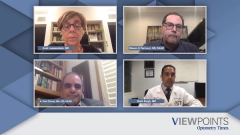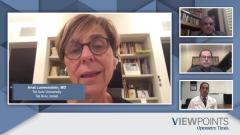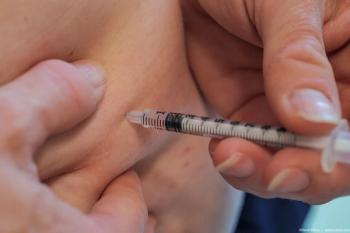
Diabetes management: OD and MD communication
Episodes in this series

Rishi Singh, MD: Dr Ferrucci, what are the keys to getting successful communication to our providers? What do you send in that referral letter? What information do you think is helpful to them?
Steven G. Ferrucci, OD, FAAO: There are a couple of things. Number 1, it is often the case that the patients we see as optometrists may have been seen in our practice for many years. It may be a patient with type 2 diabetes who we’ve seen for many years, and we’re now seeing their vision take a turn for the worse. When I send the patient to a retina specialist, I give a brief background and tell them what my concern is and why I’m concerned. I highlight the main concern without a lot of extraneous information. You should get down to the meat and bones of why the patient is being sent over, what you want them to look at, and what you would like their opinion on.
Rishi Singh, MD: Dr Chous, how does the primary care provider [PCP] fit into this discussion in that case?
A. Paul Chous, OD, MA, FAAO: It’s important that we’re giving consistent messages to patients. Regardless of whether a patient has diabetic retinopathy [DR], it’s imperative that all of us in primary eye care send a note to the PCP letting them know that, if the patient has developed any DR, they need referral to a retina specialist. The other important thing is what the surveillance interval is. When does the patient need to be seen by us again to monitor their disease if they have any diabetic retinal disease? It’s a great opportunity for collaboration with PCPs. We know that DR in particular is linked to many other comorbidities of diabetes, so it represents an opportunity to collaborate not only with PCPs but a variety of subspecialists, as well.
Rishi Singh, MD: Dr Loewenstein, go ahead.
Anat Loewenstein, MD: I want to add to that that the role of the optometrist is crucial. It doesn’t matter in which country you live because the patients often don’t even go to an ophthalmologist. They are often going just to change their glasses. They would then go to optometrists all over the world, and…that’s a chance to catch the patient, examine them, and decide whether to send them to a specialist. It’s a crucial role.
Rishi Singh, MD: What do you look for, Dr Loewenstein, in your referrals? What are you hoping to hear from your optometrist or any other eye care provider when they’re sending a patient to you? What do you want to hear from them about the diabetes?
Anat Loewenstein, MD: It is exactly what Paul and Steve said. I want to know that they have had good visual acuity until now, and they have now seen the visual acuity deteriorate. I want to know that they followed up with them for many years and didn’t see any diabetic retinopathy and that this is something for which the patient now doesn’t get maximal visual acuity.
Rishi Singh, MD: Yes, and I always send a letter to the primary care provider because they usually have concurrent disease otherwise, and there might need to be some modification of therapy for those diseases that can develop. Patients are obviously at a higher risk for cardiovascular morbidities and mortality, and obviously for kidney disease, as well as neuropathy. I always send a letter to the primary care doctor. Dr Loewenstein, what do you send to the primary care doctor, and what do you tell them about the disease?
Anat Loewenstein, MD: I tell them that the patient has diabetic retinopathy and that they should be monitored for their diabetic glucose levels, hemoglobin A1C [glycated hemoglobin]. I know that they know that the patient needs to be monitored and that they need to have their blood pressure and lipid situation monitored in these situations.
The communication with the primary care physicians is really important, especially because of the DRCR [Diabetic Retinopathy Clinical Research] Network trials looking at the importance of education done by ophthalmologists. Surprisingly, it was found that the ophthalmologist’s education of the patients was not important. It didn’t change anything. The way the ophthalmologists educate the patients does not change the final visual acuity outcome. It’s quite surprising for me because I make it my business to tell the patients that they need to have their blood glucose and blood pressure controlled.
A. Paul Chous, OD, MA, FAAO: I’m curious. How many of the rest of the panelists get letters back from the primary care physician about recommended glycemic goals for a patient?
Anat Loewenstein, MD: Very rarely.
A. Paul Chous, OD, MA, FAAO: Yes. Patients who have had diabetes for 30 years with comorbidities, the A1C target may be 8%, not 7%, so it’s important that we give messages that are complementary to those given by the PCP.
Anat Loewenstein, MD: That’s right.
A. Paul Chous, OD, MA, FAAO: I’d like to get more letters than I do.
Newsletter
Want more insights like this? Subscribe to Optometry Times and get clinical pearls and practice tips delivered straight to your inbox.





























































.png)


